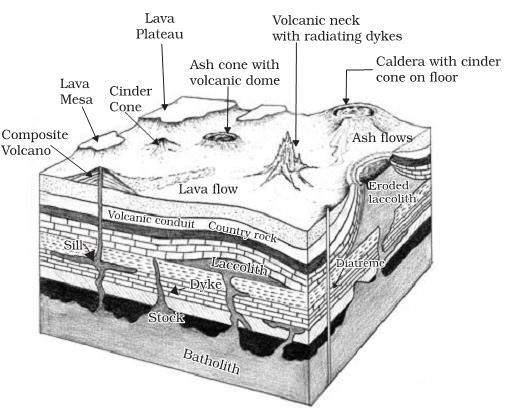NCERT notes on important topics for the UPSC civil services exam. These notes will also be useful for other competitive exams like banking PO, SSC, state civil services exams, and so on. This article talks about the landforms formed by Volcano eruption.
Volcanic Landforms (UPSC Notes):- Download PDF Here
Volcanic Landforms
Volcanic landforms
Volcanic eruptions result in the formation of landforms and here we are going to discuss volcanic landforms.
Intrusive Forms
- The lava that is discharged during volcanic eruptions on cooling develops into igneous rocks.
- The cooling may take place either on arriving on the surface or also while the lava is still in the crustal portion.
- According to the location of the cooling of the lava, igneous rocks are categorized as plutonic rocks and volcanic rocks.
- The lava that cools inside the crustal portions takes diverse forms. These forms are called intrusive forms.
Some of the forms are shown in Figure given below

Batholiths
- Batholiths are the cooled portion of magma chambers.
- It is a large body of magmatic material that cools in the deeper depth of the crust molds in the form of large domes.
- They appear on the surface only after the denudation processes eliminate the overlying materials.
- These are granitic bodies.
Laccoliths
- These are large dome-shaped intrusive bodies with a level base and linked by a pipe-like channel from below.
- It bears a similarity to the surface volcanic domes of the composite volcano, only these are located at deeper depths.
- It can be considered as the localized source of lava
- The Karnataka plateau is patterned with dome hills of granite rocks.
Lopolith
- When the lava moves upwards, a part of the same tends to move in a horizontal direction wherever it finds a weak plane.
- It can get rested in various forms. If it develops into a saucer shape, concave to the sky body, it is called lopolith.
Phacolith
- It is a wavy mass of intrusive rocks found at the base of synclines or the top of the anticline in the folded igneous country.
- These wavy materials have a definite outlet to source beneath in the form of magma cavities.
Sills
- The near horizontal bodies of the intrusive igneous rocks are called sill
- The thick horizontal deposits are called sills whereas the thinner ones are called sheets.
Dykes
- Dykes are the most commonly found intrusive forms in the western Maharashtra area.
- When the lava makes its channel through cracks and the fissures, it solidifies almost perpendicular to the ground.
- This gets cooled in the same position to grow a wall-like structure. Such structures are known as dykes.
- These are regarded as the feeders for the eruptions that led to the development of the Deccan traps.
Volcanic Landforms (UPSC Notes):- Download PDF Here
Also, see:
| Volcanoes |
| Earthquake |
| Structure of the Earth |
UPSC Preparation
| UPSC Prelims 2023 | UPSC Mains 2023 |
| UPSC Exam Pattern | IAS Exam |
| UPSC Books | Daily News Analysis |
| UPSC Previous Year Question Papers | IAS Current Affairs |
| NCERT Notes For UPSC | Daily Video Analysis: The Hindu |
Comments